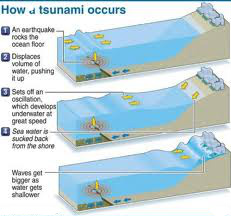
Tsunami is a natural-disaster-causing act of the ocean. The name is derived from Japanese words ‘tsu’ that means ‘harbour’ and ‘o’name’, which means ‘wave’. This wave is gigantic, powerful and catastrophic. It has damaged acres of land, killed thousands of people and destroyed properties including various constructions. There have been such deathly incidents across the world. Let’s find out more about Tsunami and its causes.
Though ‘Tsunami’ mean ‘harbour wave’ (as per its Japanese translation), it is not a single giant-like wave. It is indeed formed by a number of waves across the ocean. A series of waves rush to the ones in their front and finally all these waves join together as one which is monstrous and deadly. The wave grows in size, strength and speed shaping up into Tsunami. It spreads across the ocean travelling in a speed of hundreds of kilometres per hour and reaching a height of some hundreds of metres. It builds up the height and strength as it approaches the shore and finally when it reaches the shore; it crashes down causing destructions on a wide scale. The biggest Tsunami ever recorded was the Tsunami of 1958 along the Fairweather Fault in Lituya Bay, Alaska. It was 524 metres tall, above the sea level.
Tsunamis have a speed ranging from 800 to 965 kilometres per hour, wave period of 10 minutes to 2 hours and a wavelength of 100 to 500 kilometres apart. Thus, two consecutive waves of a Tsunami take 10 minutes to 2 hours to cross a single point and the distance between the consecutive crest of Tsunami is 100 to 500 kilometres. A normal Tsunami has a wave height of 30 metres which is the distance between the crest and trough of Tsunami. When the Tsunami nears the landfall, it grows in height and more is the height especially when there are steeper shorelines. The wavelength and speed of Tsunami is comparatively more when it is in deep ocean than in the shore. As the Tsunami approaches the shore, the wavelength and speed decreases but the height grows. This is known as shoaling effect. When the Tsunami hits the shore, large amount of water is push onto the shore above and is known as runup. This runup is also capable of causing massive destruction to the surrounding.
Tsunami has its root cause underwater. Three causes of Tsunami are:
-
When there is an earthquake underwater that moved the tectonic plates, the plate boundaries either rise or fall. This movement suddenly displaces water forming huge rolling waves which would finally become Tsunami.
-
Other reasons for Tsunami are rockfalls, icefalls or earthquakes that result in underwater landslides. Underwater volcanic eruptions are also a reason behind the cause of Tsunamis.
-
Tsunamis arise majorly from the Pacific Ocean’s ‘Ring of Fire’ where there are hundreds of volcanoes. As soon as there is a tectonic shift underwater resulting in volcanic eruptions or earthquake and thus giving rise to a Tsunami.
-
Another rare cause of Tsunami is the impact of a meteorite into an ocean. It also displaces a huge amount of water from the ocean from its level thus forming a Tsunami.

Tsunamis had always been destructive and had destroyed properties and lives. Some of the most dangerous Tsunamis were recorded in the following places:
-
Sumatra, Indonesia: The Tsunami of 26 December 2004, hit the coast Sumatra causing a damage of nearly 10 billion dollars and killed nearly 230,000 lives. It was caused by an underwater earthquake at a depth of 30 kilometres. The earthquake had 9.1 magnitudes and the Tsunami reached a height of 50 metres and reached out for nearly 5 kilometres till the Meubolah, Sumatra.
-
North Pacific Coast, Japan: On 11 March 2011, a Tsunami hit the east coast of Japan caused by an underwater earthquake with 9.0 magnitudes at a depth of 24 kilometres. The earthquake gave rise to a Tsunami that had a speed of 800 kilometres per hour and 10 metres tall. The Tsunami killed more than 18,000 people and nearly 452,000 people were evacuated from their destroyed homes. There was a damage of nearly 235 billion dollars.
-
Lisbon, Portugal: Three huge Tsunami waves hit the towns at the western coast of Portugal and southern Spain. The Tsunami was caused by an earthquake of 8.5 magnitude and the Tsunami waves reached up to a height of 30 metres. It killed more than 60,000 people in Portugal, Morocco and Spain.
There are three major warning signs before Tsunami arrives. They are:
-
The ground in the coastal region will shake as a result of the underwater earthquake.
-
There might be a fast tide ebbing away from the shore which indicates the return of a fast moving Tsunami.
-
The most obvious is the roar indicating the arrival of the Tsunami.
G Kowledge of | 0 Comments >>
0 Comments
Leave Comment
Your email address will not be published. Required fields are marked.